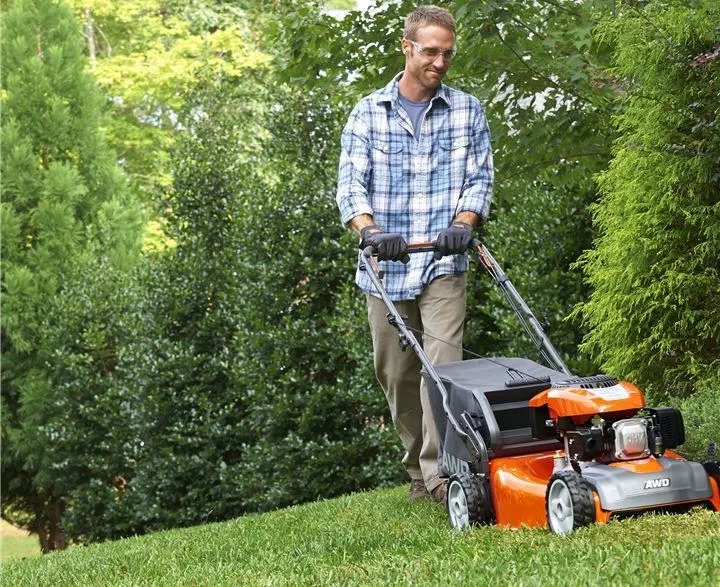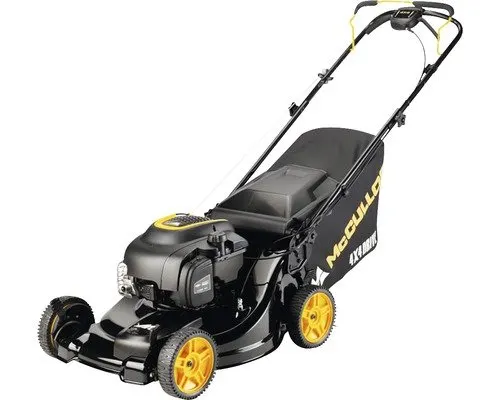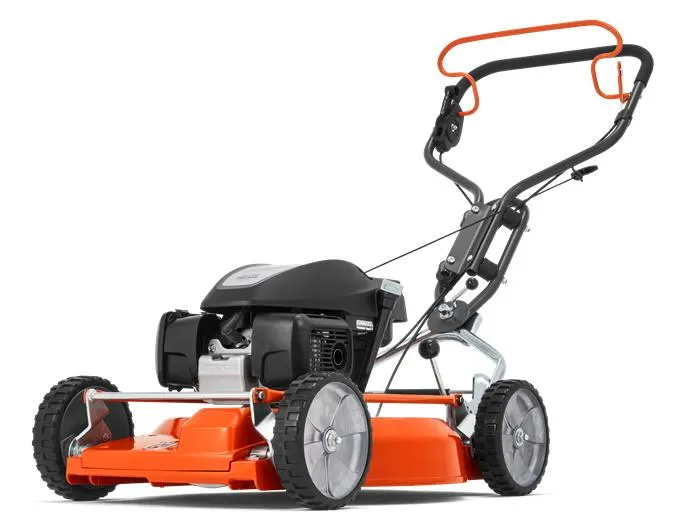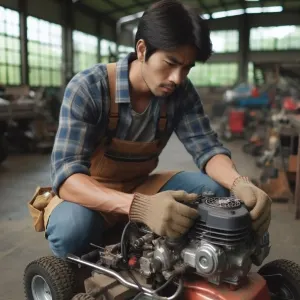Have you ever been curious about your lawnmower’s full range of capabilities? We’re here to shed light on one particular feature that might surprise you – its ability to move backward. With our extensive expertise, we can guide you through this lesser-known functionality.
A self-propelled lawnmower cannot mow grass backward under its power, as the blades are designed to cut grass when moving forward. While a self-propelled mower can be manually pulled back, this is not recommended, as it reduces visibility and poses safety risks, especially on slopes where balance is compromised.

Are you fascinated by how things work? We’re exploring a surprising feature of a tool you thought you knew well. Ready for the revelation? Continue with us!
Contents
Can a self-propelled mower go backward?
After deciding that a self-propelled lawnmower is the right choice, you must consider one more detail: Is your lawn flat or hilly? This difference will determine whether you need a front-wheel-drive (FWD) or rear-wheel drive (RWD) self-propelled lawnmower.
A rear-wheel-drive (RWD) self-propelled lawnmower provides much better traction and is designed for hilly slopes. It runs on its back pair of wheels instead of the front ones. It is most effective when used with a bagger because the bag’s weight will cause its front end to rise when this bag flips up.
While the front-wheel-drive (FWD) models are easy to operate, allowing you to turn them by just tipping their front wheels to lift them off the ground, they work best on flat plain lawns. A self-propelled lawnmower can go backward by only disengaging its blade and its drive motor.
In my two decades of experience, I’ve seen that some models of self-propelled lawnmowers can go backward, but it largely depends on the specific model and manufacturer.
• Understanding the Basics of a Self-Propelled Mower
You can tip your self-propelled lawnmower upwards and roll it in whatever direction. Whether your mower is front-wheel drive (FWD), rear-wheel drive (RWD), or All-wheel drive (AWD), the process of backward movement remains the same.
The only thing when pulling it backward is to make sure you move it forward a couple of inches after releasing the self-propelled so it doesn’t offer resistance when pulling self-propelled mowers backward. There is a lever to engage its wheels for self-propulsion.
If this lever is neutral, you can move your self-propelled lawnmower rearwards on its four wheels.
But if no lever exists and your lawnmower is always self-propelled, you must raise its wheels to move the mower rearwards. When pulling self-propelled mowers backward, you need to move them forward a couple of inches after releasing them so it doesn’t offer resistance.

• Engaging and Disengaging the Blade
When you pull its engagement lever back to disengage the blade and drive off your self-propelled lawnmower, you can remove it backward, push it forward, or go sideways anywhere you wish to move.
After you release its drive handle on your self-propelled lawnmower, moving it forward a couple of inches and pulling it back always allows you to go rearwards.
However, if you release its drive handle and pull it back, sometimes it will not move around. So you will have to push it again a couple of inches forward; you will find it goes backward now.
• How the Ratchet Assembly Facilitates Rearward Motion
Each wheel on your self-propelled lawnmower has a ratchet. The ratchet allows free wheel motion when going rearwards. The woodruff key within the ratchet assembly catches its perpendicular slope when your lawnmower is driven.
When you try to pull your lawnmower backward, the inclined slope of the ratchet assembly pushes its woodruff key back into the critical seat of the shaft to let it wheel freely.
Before planning a backward grass mowing, it is necessary to survey the height of your grass, its dryness or dampness, remove any obstacles, and grease the mower’s belt, handle, drive bar, internal ratchet teeth, springs, shaft key seats, and woodruff drive keys.
Should Self-Propelled Mowers Mow Backward?
One crucial fact about lawn mowing is that mowing your grass backward is not safe. Despite this, there is a high demand for the backward movement of a self-propelled lawnmower. Although people fully know the risks, safety concerns, and performance, they want self-propelled lawnmowers that mow rearwards.
Self-propelled lawnmowers can throw out debris with extreme velocity and power. The blades of a self-propelled push lawnmower can injure a careless user. Some of the latest models come equipped with a dead man’s switch to disable the blade rotation immediately when the user no longer holds the handle.
Over twelve thousand people yearly are hospitalized in the United States due to lawnmower accidents. These accidents can be prevented by wearing protective footwear when mowing.
The American Academy of Pediatrics recommends that children be at least twelve years old before using a walk-behind lawnmower and at least sixteen years before using a riding mower.

• The Growing Market for Self-Propelled Lawnmowers
The expanding market has mandated that the major and the most popular manufacturers make self-propelled lawnmowers with a backward movement feature/specification.
An alarming safety concern of backward lawn mowing is that an average of one child per day is knocked over by a self-propelled lawn mover going rearwards.
Customers continue to ignore safety concerns and statistics, so I must explain the logical reasons why backward lawn mowing is not safe. When you mow backward, your visibility is blocked.
You will have to alter your vision line. There is a risk that you fall into some ditch, collide with a garden ornament, or, worse of all, your young child or pet.
Some self-propelled lawnmowers have protective flaps to prevent injury to your foot; make sure the flaps on your mower are in good condition. Otherwise, you are at the risk of cutting off your toes. If your jeans or skirt is too long, getting entangled in the mower blades while mowing backward is more dangerous.
The mechanics that allow a self-propelled lawnmower to move backward involve the lawnmower’s transmission, which, when put into reverse, changes the rotation of the wheels.
Mowing on Slopes
If your lawn is hilly with numerous steep slopes, there is an even greater risk of falling when mowing backward. The mass of the machine combined with your body mass creates greater chances of losing balance and tripping over with the machine rolling over your body. This can be life-threatening.
Some self-propelled lawnmowers will not perform any better when moving backward. Your grass does not get discharged beneath its deck. The cut is uneven, unbalanced, and irregular when you force its blades to run in reverse.
Many blades of grass will remain intact and untouched, resulting in an unpleasantly choppy lawn.

Pulling a self-propelled lawnmower backward is not too intelligible. Mow the grass on your lawn in the frontwards direction with its self-propel drive bar engaged to engage its self-propel feature pull and hold the drive bar towards its handle.
Now, release the self-propel drive bar to pull your lawnmower towards you in a backward direction.
Ensure your jeans are ankle-high to prevent the freshly chopped grass from striking against your legs. Wear the most sturdy shoes, garden gloves, and goggles to keep yourself safe. Finally, never light a cigarette when lawn mowing.
Can a self-propelled mower be pushed?
Yes, a self-propelled lawnmower can be pushed. It will not damage its transmissions anyway. But it is very tough to make a self-propelled lawnmower as they are much heavier than push lawnmowers.
You must push its drive clutch lever forward to propel the mower and then release its drive clutch lever to stop your lawnmower’s forward movement.
For self-propelled mowing, please press the button on top of the blade control lever of your lawnmower, push its blade control lever entirely forward, and then push its drive clutch lever forward. The drive clutch lever can hold its blade control lever against its handlebar.
Always remember to release the drive clutch lever before starting the engine. When you shift the lever, your lawnmower will move forward if its drive clutch is engaged. You must use its shift lever to select its forward speed, and you can control the self-propelled speed with its drive clutch lever.
Safety is paramount when operating a self-propelled lawnmower in reverse. Always ensure the area behind you is clear before moving backward to avoid accidents.
• Importance of the Blade Control Lever
Your lawnmower will gradually move faster as you push its drive clutch lever forward. If you push its lever forward to its handlebar, your lawnmower will move at a speed determined by its shift lever setting.
When moving and using its drive clutch lever to change self-propelled speed, you must fully hold its blade control lever against its handlebar.
It will help prevent damage to its blade control mechanism. It would be best to use its shift lever to change its maximum speed so you can hold its drive clutch lever comfortably against its handlebar as you wish to mow.
Remember never to use its throttle lever to adjust your forward speed because the position of its shift lever determines its maximum ground speed when its drive clutch lever is fully engaged.
For the best mowing performance ever, always use its lower speed range for mowing and its higher speed range for transporting. With its shift lever back and the drive clutch lever engaged, the mower will move slowly or not at all.
Remarks
To conclude this response post, we would say that a self-propelled lawnmower cannot go back under the power of its engine. Hence, it’s not designed for that functionality. It can go backward manually, however. But that can only be done by pushing it as it won’t have any rearward speed.


I never knew there was so much to consider with lawnmowers.
Thanks for sharing your insight! There’s always more to learn about lawnmowers than meets the eye. Stay tuned for more surprising features and tips in the future.
I appreciate the details provided in this article.
Thank you for your kind words, Ricky! We’re glad you found the article informative. Stay tuned for more surprising features of common tools.
I never thought about this feature of a lawnmower before.
Thank you for reading! We’re glad we could introduce you to this new aspect of lawnmowers. Stay tuned for more surprising features in the future!
I will definitely be more careful when using my lawnmower now.
Thank you for your cautious approach, Victoria. Remember, safety always comes first when operating a lawnmower. Have a great time exploring the capabilities of your machine!
How common is it for people to mow backward with self-propelled mowers?
Vicki, a self-propelled mower is not designed to mow backward under power due to safety risks. It’s possible to manually move it backward, but not recommended for safety reasons.
How do different types of self-propelled mowers handle going backward?
Self-propelled mowers are not designed to mow backward under power. Manual backward movement is possible, but not recommended due to safety concerns. Stick with forward mowing for optimal performance. Thank you!
Thank you for shedding light on this topic.
Thank you for your kind words, Erik! Stay tuned for more surprising insights into the capabilities of lawnmowers. Let’s continue this fascinating journey together.
Can a self-propelled mower go in reverse?
A self-propelled lawnmower can only be manually pulled backward, as the blades are designed for forward cutting. Safety risks and reduced visibility make this option less recommended.
This is so interesting!
Thank you, Caroline! We’re glad you found our discussion on self-propelled lawnmowers fascinating. Stay tuned for more insights and useful tips on lawn care equipment.
What are some signs that a self-propelled mower can be moved backward?
Hi Eli! We appreciate your curiosity about self-propelled mowers. Although they can be manually pulled backward, they are designed to cut grass when moving forward for safety reasons. Stay tuned for more insights on our blog!
Is there a specific way to engage the wheels for backward movement?
Hi Juan! To move your lawnmower backward, disengage the blades and drive motor. Always prioritize safety and maneuverability when moving your mower in reverse. Happy mowing!
What precautions should be taken when moving a lawnmower backward?
Thanks for your question, Kevin! Moving a lawnmower backward manually is possible but not recommended due to safety risks. Stick to forward mowing for best results.
Great explanation of how self-propelled mowers work.
Thank you, Juan! There’s always more to discover about our tools. Stay tuned for more insights on lawn mower functionalities.
This has been a very informative read.
Thank you, Terrence! We’re glad you found the information useful. Stay tuned for more surprising insights into the capabilities of your everyday tools.
Are there any safety concerns with mowing backward?
Mowing backward with a self-propelled mower is not recommended due to safety concerns. It can be manually pulled back but poses risks, especially on slopes. Stick to mowing forward for safety.
I had no idea about the risks of mowing backward.
Thank you for your insight, Michael. The risks of mowing backward are significant, and it’s crucial to prioritize safety while using a lawnmower. Stay safe!
Is it difficult to move a self-propelled mower backward manually?
Moving a self-propelled mower backward manually is possible but not recommended due to safety risks. The mower’s blades are designed for forward movement, not backward. Stay safe and mow forward!
Can you damage a self-propelled lawnmower by moving it backward?
Yes, moving a self-propelled lawnmower backward manually is possible, but not recommended due to safety risks and reduced visibility. Stick to forward mowing for the best results.
This is such helpful information!
Thank you, Taylor! We’re glad you found the information helpful. Stay tuned for more surprising insights on lawnmowers.
I had no idea lawnmowers could do this.
I’m glad you found the information helpful! It’s always fascinating to discover the hidden capabilities of everyday tools. Stay tuned for more surprises!